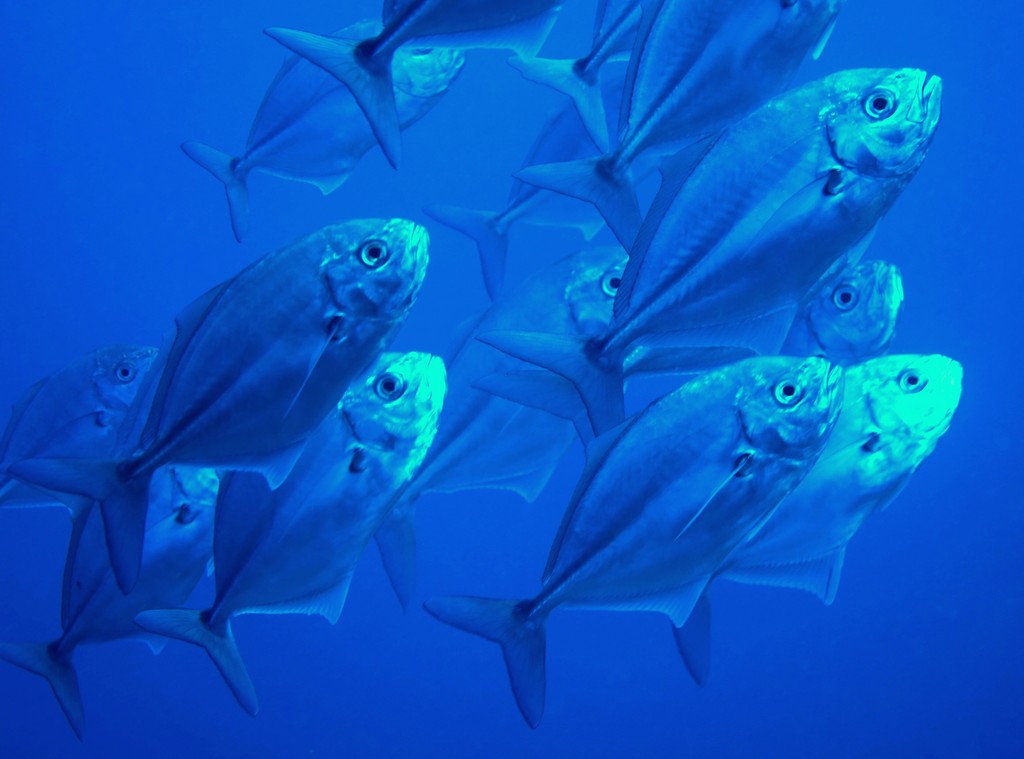URASPIS URASPIS - (GUNTHER, 1860)
Picture courtesy of: Alain Daoulas
Carangue paia, Bassett-hulls trevally, Basset-hull's trevally, Whitemouth jack, Whitemouth trevally, White-mouthed trevally, Whitetongue jack, White-tongued jack, Jurel paia, Indo-okiaji, インドオキアジ, 尾甲鰺, 正沖鰺, 白口尾甲鲹, Cá Hiếu, شيم أبيض الفم,
Synonymes
Caranx guptae (Chaudhuri, 1909)
Caranx uraspis (Günther, 1860)
Leucoglossa herklotsi (Herre, 1932)
Uraspis carangoides (Bleeker, 1855)
Uraspis pectoralis (Fowler, 1938)
----------------------------------
Description
Dorsal spines (total): 8-9; Dorsal soft rays (total): 25-30; Anal spines: 2 detached spines, followed by 1 spine; Anal soft rays: 17-22; Gill rakers: 5-7 + 13-16 = 18-22; Curved part of lateral line: 61-82 scales; Straight part of lateral line: 26-38 scutes. Body oval, compressed; Dorsal and ventral profiles equally convex. Spinous dorsal fin low; Soft dorsal and soft anal fins high but not falcate; Pectoral fins falcate, reaching to beyond junction of straight and curved lateral line segments. Curved lateral line gently arched, longer than straight line. Maxilla extends to below anterior third of eye. 1 or 2 rows of sharp conical teeth on both upper and lower jaws; No teeth on vomer, palatines or tongue. Naked area on breast broad ventrally, constricts half way to pectoral forming a narrow isthmus that connects with naked pectoral base. Max. length: 28.0 cm FL. Depth range: 20 - 130 m.
Color
Body silvery blue to silvery blue green, above silvery white below; Head silvery, mirror-like; Juveniles with 6-7 dark, vertical cross bands through body. Spinous dorsal fin black; Soft dorsal and soft anal fins hyaline, occasionally with dusky to black tips; Caudal fin dusky; Pectoral fins hyaline; Pelvic fins white to hyaline in larger specimens, inner rays dark in juveniles. Tongue and inside walls of mouth brilliant white with dark blue to black border
Etymology
Uraspis: from Greek, oura = tail + from Greek, lepis = a scale of a fish.
Original description: Caranx uraspis Günther, 1860 - Type locality: Ambon Island, Molucca Islands, Indonesia.
Distribution
Indo-West Pacific: East Africa, Réunion (western Mascarenes) and Persian Gulf east to Hawaiian Islands, north to Ryukyu Islands (Japan), south to northern Australia and New Caledonia.
Synonymes
Caranx guptae (Chaudhuri, 1909)
Caranx uraspis (Günther, 1860)
Leucoglossa herklotsi (Herre, 1932)
Uraspis carangoides (Bleeker, 1855)
Uraspis pectoralis (Fowler, 1938)
----------------------------------
Description
Dorsal spines (total): 8-9; Dorsal soft rays (total): 25-30; Anal spines: 2 detached spines, followed by 1 spine; Anal soft rays: 17-22; Gill rakers: 5-7 + 13-16 = 18-22; Curved part of lateral line: 61-82 scales; Straight part of lateral line: 26-38 scutes. Body oval, compressed; Dorsal and ventral profiles equally convex. Spinous dorsal fin low; Soft dorsal and soft anal fins high but not falcate; Pectoral fins falcate, reaching to beyond junction of straight and curved lateral line segments. Curved lateral line gently arched, longer than straight line. Maxilla extends to below anterior third of eye. 1 or 2 rows of sharp conical teeth on both upper and lower jaws; No teeth on vomer, palatines or tongue. Naked area on breast broad ventrally, constricts half way to pectoral forming a narrow isthmus that connects with naked pectoral base. Max. length: 28.0 cm FL. Depth range: 20 - 130 m.
Color
Body silvery blue to silvery blue green, above silvery white below; Head silvery, mirror-like; Juveniles with 6-7 dark, vertical cross bands through body. Spinous dorsal fin black; Soft dorsal and soft anal fins hyaline, occasionally with dusky to black tips; Caudal fin dusky; Pectoral fins hyaline; Pelvic fins white to hyaline in larger specimens, inner rays dark in juveniles. Tongue and inside walls of mouth brilliant white with dark blue to black border
Etymology
Uraspis: from Greek, oura = tail + from Greek, lepis = a scale of a fish.
Original description: Caranx uraspis Günther, 1860 - Type locality: Ambon Island, Molucca Islands, Indonesia.
Distribution
Indo-West Pacific: East Africa, Réunion (western Mascarenes) and Persian Gulf east to Hawaiian Islands, north to Ryukyu Islands (Japan), south to northern Australia and New Caledonia.
Biology
Adults occur in the continental shelf. They form schools. They feed on epibenthic crustaceans and cephalopods.
Similar species
Uraspis secunda (Poey, 1860) - Reported from Circumglobal in tropical and subtropical seas (absent from New Caledonia) - Differs in having the curved part of the lateral line (with 48-66 scales) shorter than the straight part vs. the curved portion (with 61-82 scales) usually longer than the straight part in Uraspis uraspis.
Similar species
Uraspis secunda (Poey, 1860) - Reported from Circumglobal in tropical and subtropical seas (absent from New Caledonia) - Differs in having the curved part of the lateral line (with 48-66 scales) shorter than the straight part vs. the curved portion (with 61-82 scales) usually longer than the straight part in Uraspis uraspis.
